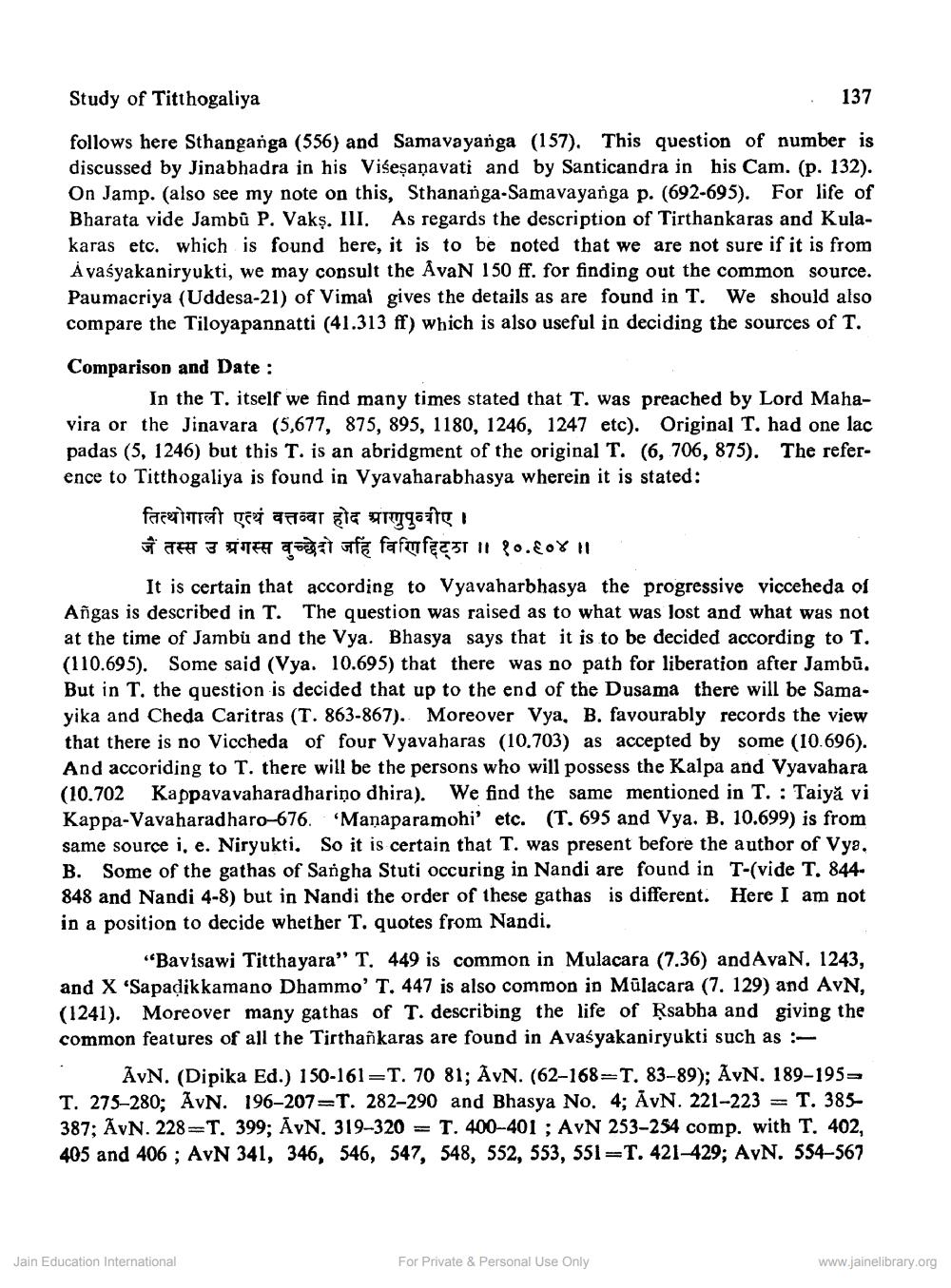Book Title: Study of Titthogaliya Author(s): Dalsukh Malvania Publisher: Z_Jinvijay_Muni_Abhinandan_Granth_012033.pdf View full book textPage 9
________________ Study of Titthogaliya 137 follows here Sthanganga (556) and Samavayanga (157). This question of number is discussed by Jinabhadra in his Višeṣanavati and by Santicandra in his Cam. (p. 132). On Jamp. (also see my note on this, Sthananga-Samavayañga p. (692-695). For life of Bharata vide Jambu P. Vaks. III. As regards the description of Tirthankaras and Kulakaras etc. which is found here, it is to be noted that we are not sure if it is from Avasyakaniryukti, we may consult the AvaN 150 ff. for finding out the common source. Paumacriya (Uddesa-21) of Vimal gives the details as are found in T. We should also compare the Tiloyapannatti (41.313 ff) which is also useful in deciding the sources of T. Comparison and Date : In the T. itself we find many times stated that T. was preached by Lord Mahavira or the Jinavara (5,677, 875, 895, 1180, 1246, 1247 etc). Original T. had one lac padas (5, 1246) but this T. is an abridgment of the original T. (6, 706, 875). The reference to Titthogaliya is found in Vyavaharabhasya wherein it is stated: तित्थोगाली एत्थं वत्तव्वा होद प्रागुपुत्रीए । जैं तस्स उ अंगस्स बुच्छेदो जहि विरिणाि ।। १०. ६०४ ।। It is certain that according to Vyavaharbhasya the progressive vicceheda of Añgas is described in T. The question was raised as to what was lost and what was not at the time of Jambu and the Vya. Bhasya says that it is to be decided according to T. (110.695). Some said (Vya. 10.695) that there was no path for liberation after Jambū. But in T. the question is decided that up to the end of the Dusama there will be Samayika and Cheda Caritras (T. 863-867). Moreover Vya, B. favourably records the view that there is no Viccheda of four Vyavaharas (10.703) as accepted by some (10.696). And accoriding to T. there will be the persons who will possess the Kalpa and Vyavahara (10.702 Kappavavaharadharino dhira). We find the same mentioned in T. Taiyă vi Manaparamohi' etc. (T. 695 and Vya. B. 10.699) is from Kappa-Vavaharadharo-676. same source i, e. Niryukti. So it is certain that T. was present before the author of Vya. B. Some of the gathas of Sangha Stuti occuring in Nandi are found in 848 and Nandi 4-8) but in Nandi the order of these gathas is different. in a position to decide whether T. quotes from Nandi. T-(vide T. 844Here I am not "Bavisawi Titthayara" T. 449 is common in Mulacara (7.36) and AvaN. 1243, and X 'Sapadikkamano Dhammo' T. 447 is also common in Mülacara (7. 129) and AvN, (1241). Moreover many gathas of T. describing the life of Rsabha and giving the common features of all the Tirthankaras are found in Avasyakaniryukti such as : AvN. (Dipika Ed.) 150-161-T. 70 81; AvN. (62-168-T. 83-89); AvN. 189-195T. 275-280; AvN. 196-207-T. 282-290 and Bhasya No. 4; AvN. 221-223 T. 385387; AvN. 228-T. 399; AvN. 319-320 T. 400-401; AvN 253-254 comp. with T. 402, 405 and 406; AvN 341, 346, 546, 547, 548, 552, 553, 551-T. 421-429; AvN. 554-567 Jain Education International For Private & Personal Use Only www.jainelibrary.orgPage Navigation
1 ... 7 8 9 10
